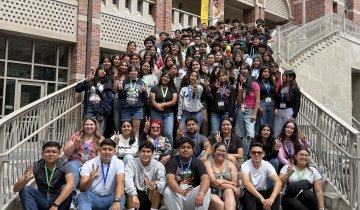Maribel Perez-Espinal felt out of place when she arrived at Humboldt State University, the most remote college in the Cal State system. Everyone she met in her first weeks on campus was nice and inviting, but they didn’t look like her.
Many first-generation college students struggle to find a sense of belonging at their universities, and administrators at Humboldt understood this issue was intensified by the culture shock students from urban areas have in coming to the northernmost part of the state, among the redwood forests.
Latino enrollment at the university has doubled over the past 20 years, but the surrounding county is still 80 percent white. Perez-Espinal came from Stockton, Calif., where 40 percent of the population is Hispanic or Latino.
As part of the CSU STEM Collaboratives project, Humboldt sought to help students such as Perez-Espinal feel a connection to the region through a place-based theme designed around the Klamath River, the state's second-longest river, which runs through Humboldt County on its way from Oregon to the Pacific Ocean.
“The Klamath Connection program connected us to the land, the people and the surroundings here at Humboldt,” says Perez-Espinal, who is entering her junior year majoring in biology with the ultimate goal of becoming a neurosurgeon. “It’s a connection so deep that I would say it will be hard to leave once my time is up here as a student.”
The STEM Collaboratives is the first CSU program to connect existing interventions into an integrated approach, incorporating both curricular innovation and out-of-class support for first-year STEM students on a large scale.
The Pullias Center for Higher Education at USC Rossier ran a three-year evaluation of the project, completing a final report in August.
“At the Pullias Center, we’re always looking for systemic, scalable solutions,” says Professor Adrianna Kezar, co-director of the center and principal investigator of the project. “CSU is the nation’s largest four-year public university system. For the Pullias Center’s commitment to study innovative and scalable approaches to supporting first-generation, low-income, student access, transition and success, CSU is where programs can have the greatest impact.”
WHAT IS THE CSU STEM COLLABORATIVES?
Funded by a $4.6 million grant from the Helmsley Charitable Trust and coordinated through the CSU Chancellor's office, CSU STEM Collaboratives tasked eight universities to link at least three high-impact practices and create an integrated environment of support for STEM students in their first year.
Transition from high school to college can be extremely challenging, especially for students of color, first-generation college students or any students who did not receive adequate academic preparation in high school. Introductory courses in STEM fields tend to be structured to weed out students rather than compensate for this lack of preparation.
Nationally, 46 percent of white and Asian students majoring in STEM complete a degree in six years, compared to less than one-third of Latino students and about 20 percent of African-American students. Despite decades of focus and effort invested into fixing this problem, attrition from STEM majors remains high, especially during and after the first year.
Each participating campus implemented a summer bridge experience for incoming freshmen, a first-year experience or seminar and redesigned introductory STEM courses.
Another key part of the effort was bridging the traditional divides between student affairs staff and faculty members to have everyone working toward rethinking the ways in which they support first-generation students as they transition to college.
At Humboldt, faculty got excited about interdisciplinary and field-based research that incorporated real-world problems, staff resonated with the idea of working with the community and parents liked the idea of classes guaranteed to count for students' majors.
“The intention was that if we want students to succeed, we need to start looking at underlying structures and having faculty and staff collaborate can make a much bigger impact than having several isolated programs,” Kezar says.
USC'S ROLE
The CSU administrators secured the services of Kezar and the Pullias Center to conduct a study to help them understand whether the program worked and how it was supporting student success.
Kezar and research assistant Elizabeth Holcombe, who is pursuing her PhD in urban education policy with a focus in higher education at USC Rossier, conducted the analysis with a multi-method case study approach.
They collected data through surveys and document analysis, observed project meetings, and visited each campus to hold interviews and focus groups with students, faculty, staff and administrators.
“Adrianna and Elizabeth were really supportive and seemed to be excited about our particular model,” says Professor Matthew Johnson, co-director of Klamath Connection at Humboldt. “Adrianna has so much experience with institutional change, she is able to offer advice on strategies for engaging students and marshaling support from faculty and staff.”
TWO VERY DIFFERENT MODELS OF SUCCESS
The 68-page final report produced by the Pullias Center reviews all eight campuses but highlights the varied paths to success taken by two campuses: Humboldt and Cal State University, Dominguez Hills.

Humboldt began with a summer excursion to the Klamath River Basin to show students some of the social, cultural and economic challenges of the region — as well as its beauty — providing an early geographic and cultural connection to their new home. Courses were modified to include components related to the Klamath Connection theme, as was a one-credit first-year seminar, making the first-year curriculum more engaging to students.
“We wanted students to see how what they’re learning relates to a place, and hopefully draw some parallels for them to compare to their communities back home,” Johnson says.
The overall retention rate for Klamath Connection students at Humboldt increased by 12 percent, the highest improvement among the participating campuses.
While Humboldt has a community of students living on campus, most Dominguez Hills students do not live on or near campus. It’s an urban, commuter school with many students living complicated lives, including students in their 30s who are often juggling school with a job and family.
The study lauds Dominguez Hills for the adjustments made to overcome implementation barriers in the initial year of its First-Year Undergraduate STEM Experience (FUSE) program, recognizing that working students may benefit from a shorter summer program and more interventions in their classes.
One such intervention was the addition of supplemental instructors. “Having a supplemental instructor helped a lot in class,” says Martin Vera, a sophomore computer science major at Dominguez Hills. “The FUSE events also helped with transitioning to college. I wasn’t the most talkative student, so having the events helped me make some friends.”
It took collaboration in the second year to overhaul the program with better integrated processes to account for the varying levels of academic preparation and the commuting nature of their students.
“Students have a lot of busy days,” says Professor Matthew Jones, associate director of the Center for Innovation in STEM Education at Dominguez Hills. “To plan something outside classroom hours, it was hard to get students to come to that initially. We redesigned the program to integrate it into their math class.”
The success is apparent in the data: Students in the redesigned precalculus course are passing at nearly double the rate of students in non-redesigned sections.
Both Humboldt and Dominguez Hills block-enrolled summer participants in cohorts to address the negative climate researchers have identified in introductory STEM courses characterized by a sense of competition rather than community.
The report asserted that this strong cohort experience was evident at Humboldt, as numerous faculty and staff commented on the Klamath Connection students “traveling in herds” and always spending time together. One student at Dominguez Hills noted “a lot of community within STEM majors” from taking summer and fall courses with the same group of peers.
FINDINGS AND RECOMMENDATIONS
The Pullias Center study’s main takeaway is that the specific interventions matter less than the integration of academics and student affairs. There is little evidence that the three specific interventions used are necessary for STEM students’ success.
Rather, the value of the program came from integrating these interventions to create a cohesive educational experience for first-year STEM students and from the unified community of support that resulted.
“No matter which high-impact practice they are using, students are getting an integrated experience to make connections across different elements of the college experience and build relationships with faculty, staff and other students,” Holcombe says. “Everyone is working toward the goal of supporting these students. That’s more important than implementing a first-year experience or a summer bridge program. Those are vehicles to get to the larger goal.”
In order to make a significant difference in the persistence and graduation rates of first-generation, low-income students in STEM, the report recommended bridging the divide between academic and student affairs, altering institutional policies and practices that work against collaboration, rethinking workload and reward policies for faculty and staff to support collaboration, facilitating faculty involvement in STEM success initiatives, tapping into programs on campus that already work with STEM or first-generation issues and using data to inform program design and redesign.
“It is our hope that the lessons in this report will inform stakeholders at other institutions and organizations interested in collaborating across departmental and unit boundaries to rethink the ways in which they support first-year students in STEM,” Kezar says. “Especially students from traditionally underserved backgrounds.”
Many of the Cal State universities — including Humboldt and Dominguez Hills — are using evidence of their programs’ success to help them to continue the efforts they began under the CSU STEM Collaboratives project.
Johnson notes that the study “helped the administration recognize that growing the program was helpful not only to students but also to the campus at large.”
“We seem well poised to expand this place-based learning community model to be available to all incoming science students at Humboldt State,” Johnson adds. “It was huge to have these data and to show campus and other external funders that this idea is worth pursuing.”





